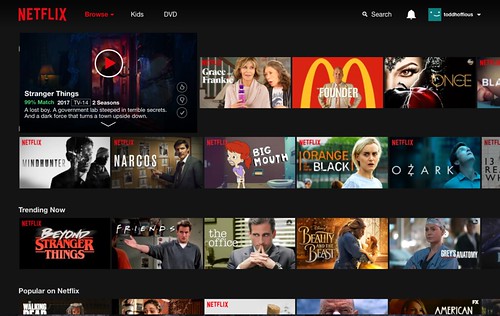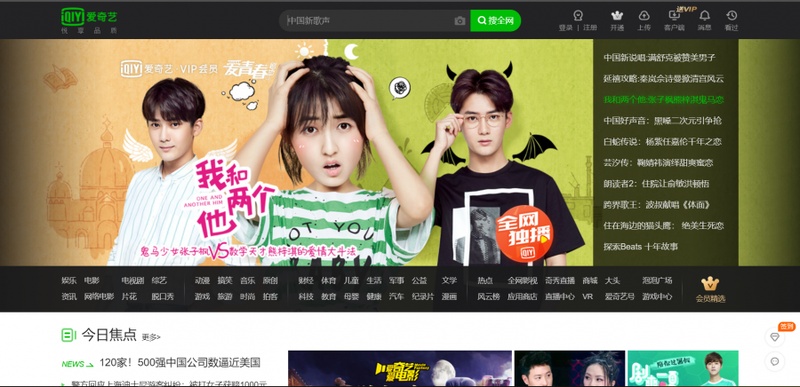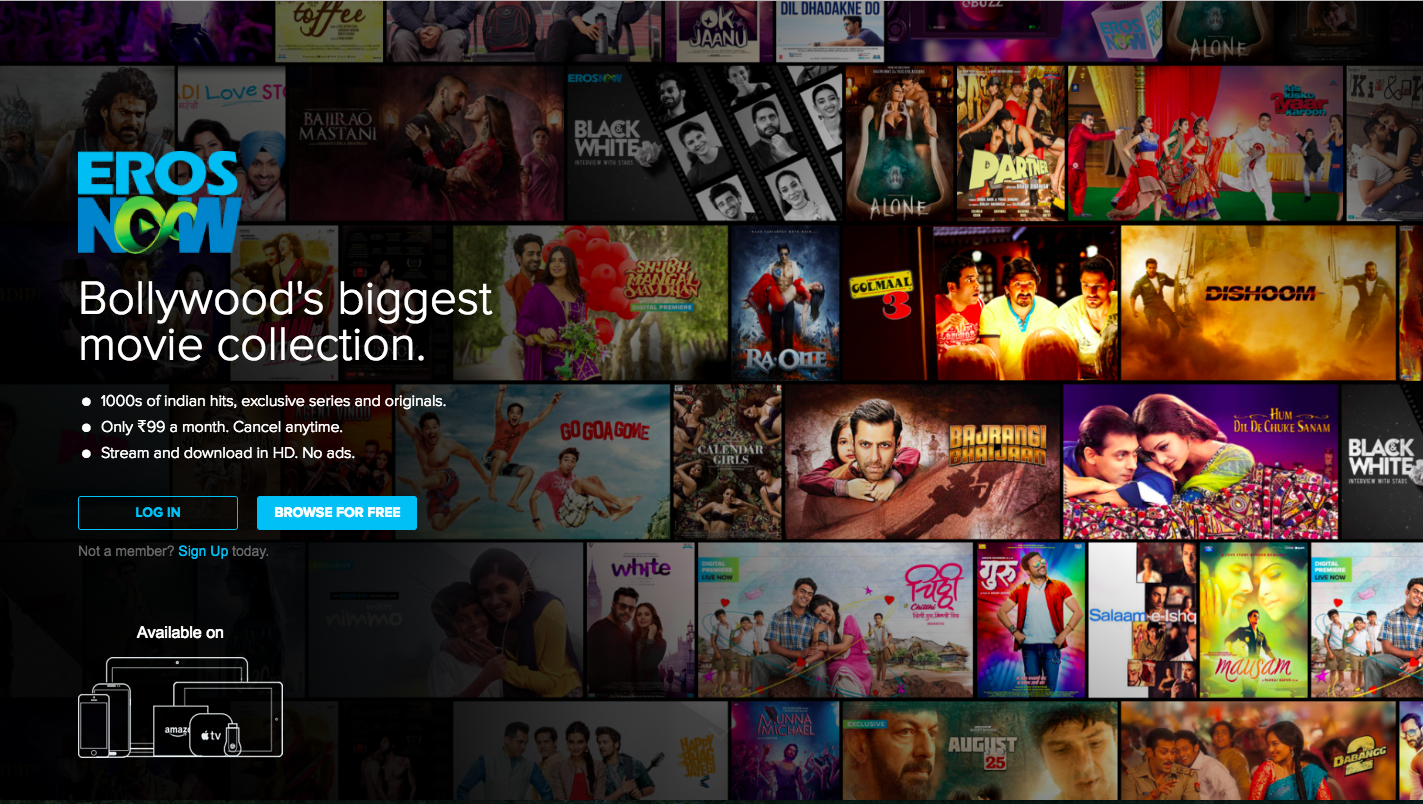What is a VOD Platform?
A platform that allows users to access video content with their time preferences. Without any schedule, you can watch content anywhere from any device. Users will have complete control to pause, fast forward content.
Example: Netflix, Disney+ are a few of the top VOD platforms.
Video on demand (VoD) services is ushering in an era of convenience for the digital consumer. These are newer, sometimes much more affordable, alternatives to cable entertainment. Connectivity allows consumers to shift to VOD platforms, without sacrificing quality content.
Now, all eyes are on Asia as it’s predicted to be the main driver of growth in the VOD industry. Here’s a list of the best VoD platforms used among Asians.
Table of Contents:
- Analysis of VOD Platform Market Trends
- Successful Content Strategies of VOD platforms
- Top Video-on-Demand Platforms from China
- Top Video-on-Demand Platforms from Southeast Asia
- Top Video-on-Demand Platforms from India
- Top Video-on-Demand Platforms from South Korea
- Other Video-on-Demand Platforms
- How To Build Your Own Video On Demand Platform?
- FAQs
Explore More ✅
Build Your Own VOD Platform With VdoCipher
Vdocipher helps several VOD Platforms to host their videos securely, helping them to boost their video revenues.
Analysis of VOD Platform Market Trends
The Video-on-Demand (VOD) platform market in Asia is characterized by rapid growth and diversity. Key factors driving this growth include:
- High Internet Penetration and Mobile Usage – Asia’s large and growing internet user base, coupled with high mobile device penetration, provides a fertile ground for VOD services.
- Diverse Consumer Preferences – Asian audiences have varied content preferences, leading to a demand for a wide range of genres and languages. This diversity encourages VOD platforms to offer a mix of international, regional, and local content.
- Rise of Local Players – Unlike Western markets dominated by global giants like Netflix and Amazon Prime, Asia sees strong competition from local players like iQiyi in China, Hotstar in India, and Iflix in Southeast Asia, which offer content tailored to local tastes.
- Original Content Production – Following the global trend, Asian VOD platforms are increasingly investing in original content to differentiate themselves and attract subscribers.
- Technological Innovation – Adoption of advanced technologies such as AI for personalized content recommendation and high-quality streaming capabilities (like 4K) is becoming a standard among Asian VOD services.
- Regulatory Environment – The regulatory landscape in Asia varies significantly across countries, affecting the operation and content strategy of VOD platforms, particularly in terms of censorship and local content quotas.
- Monetization Models – There’s a mix of monetization strategies in the Asian VOD market, including subscription-based models, ad-supported content, and pay-per-view options, catering to the varied economic capabilities of the audience.
- Partnerships and Collaborations – Strategic partnerships between VOD platforms and telecom providers, content creators, and other tech firms are common, aimed at expanding content libraries and improving service delivery.
- Challenges – Key challenges include content piracy, intense competition, and infrastructural limitations in certain regions.
Successful Content Strategies of VOD platforms
- Local Content Creation – Platforms like Hotstar in India and iQiyi in China focus heavily on local content. For example, Hotstar streams popular Indian cricket leagues and iQiyi produces Chinese dramas, aligning with regional tastes.
- Original Programming – Netflix and Amazon Prime have set a trend in producing original content. Netflix’s investment in original content reached $17 billion in 2020, leading to hits like “Stranger Things”.
- Data-Driven Content Development – Platforms use viewer data to inform content creation. Netflix’s recommendation algorithm, for instance, plays a crucial role in retaining viewers by suggesting highly personalized content.
- Diverse Genre Representation – Successful platforms offer a wide range of genres, from drama to reality shows, catering to diverse preferences.
- International Expansion with Localized Content – Netflix’s strategy includes localizing content and interface for different regions, and producing local originals like “Sacred Games” in India and “Kingdom” in South Korea.
- Partnerships for Content Acquisition – Collaborations with local and international studios help platforms like Amazon Prime and Hulu expand their content libraries.
Top Video-on-Demand Platforms from China
1. Youku Tudou

Platforms: Web, iOS, Android, PC, Smart TV
Countries: China
The most populous nation in the world occupies almost half (47%) of Asia’s video on demand (VOD) market. Yet the Chinese don’t turn to global brands such as Netflix and YouTube. They stream on local websites, one of which is Youku Tudou.
Founded in September 2005, Youku Tudou started as China’s version of YouTube. E-commerce giant Alibaba acquired the company later on in 2016. It has seen tremendous growth since then, clocking in 500 million users monthly.
The video on-demand platform allows users to view, search, and share videos through many devices. It has a vast video library—from TV dramas, music videos, interviews, and the like. Like Netflix, it also offers a subscription service for its video content.
Pros – Extensive library of local content; user-friendly interface.
Cons – Limited international content; some issues with streaming quality.
User Review – “Popular for its wide variety of Chinese content, but some users report issues with buffering.”
2. Iqiyi
Platforms: Web, iOS, Android, PC, Smart TV
Countries: China
Iqiyi is also one of China’s top video-on-demand platforms. Baidu, China’s largest search engine company, launched Iqiyi in April 2010. It is currently the largest VOD platform in terms of hours spent, nearly 6 billion hours per month. The video-on-demand website also amasses 500 million active users monthly.
Iqiyi offers a hybrid freemium and subscription model. Their users can watch videos free of charge, although these are not free of ads. Premium subscribers, on the other hand, have access to ad-free video streaming, as well as exclusive releases. The streaming site also established entertainment production companies to create their video content.
Users of the VOD platform also have access to graphic novels, online games, and merchandise from the company’s intellectual property.
Pros – Large selection of Chinese dramas and movies; high-quality original content.
Cons – Subscription required for premium content; ad-heavy in free version.
User Review – “Highly praised for its original series, but ads can be intrusive.”
3. Tencent Video

Platforms: Web, iOS, Android
Countries: China
Tencent Video is also leading China’s video-on-demand pack. Tencent, the makers of messaging services WeChat and QQ, created this subscription service in April 2011. The VOD platform has 62.59 million paid subscribers as of February 2018. It also reached 137 million daily active users in the fourth quarter of 2017.
VOD streaming service attributes its massive success to its commitment to delivering high-quality content. Their self-commissioned programs consist of TV drama series, movies, variety shows, and more; which contributed to users watching more hours on the website. Its comprehensive library also contained exclusive HBO content—the only one in China—so subscribers can get caught up with well-beloved shows like Game of Thrones.
Pros – Exclusive content, including popular Chinese TV shows and movies.
Cons – Some content is region-locked; occasional app glitches.
User Review – “Appreciated for its exclusive content, but some international users face access issues.”
4. LeTV

Platforms: Web, iOS, Android
Countries: China
Way before Netflix delivered the video on-demand experience, LeTV was first. Released in 2004, it is now one of the largest online companies in China, currently valued at US$6.43 billion.
LeTV provides an extensive library with over 100,000 TV episodes and 5,000 film titles. It specializes in film and television drama, both from local and international productions. The video on demand (VOD) platform offers free, ad-supported content, subscription options, and pay-per-view content.
Pros – Offers both Chinese and international content; good streaming quality.
Cons – Subscription model can be confusing; occasional server downtimes.
User Review – “Good mix of content but some complaints about customer service.”
Top Video-on-Demand Platforms from Southeast Asia
5. iflix
Platforms: Web, iOS, Android
Countries: Malaysia, Indonesia, Philippines, Brunei, Thailand, Vietnam, Cambodia, Myanmar, Pakistan, Nepal, Bangladesh, Sri Lanka, Maldives
More Asian VOD platforms, particularly in Southeast Asia, are getting a hold of the emerging middle-class population. Like Iflix: it prides itself on delivering high-quality content in developing markets. This approach gained them 15 million subscribers since it started in 2015.
Iflix has a vast library of local and international entertainment available for streaming and downloading. It uses a localized model not only for content, as they adapt their payment options depending on the country. Philippine users, for example, can pay through prepaid data instead of using a credit card service. It also lets you watch videos on demand for one low monthly fee, along with 30 days of unlimited VIP access.
Pros – Strong selection of local and Hollywood content; affordable pricing.
Cons – Limited availability in regions outside Southeast Asia.
User Review – “Known for its affordability and local content, but has a smaller library compared to global giants.”
6. HOOQ

Platforms: Web, iOS, Android
Countries: India, Indonesia, Philippines, Singapore, Thailand
Entertainment companies Sony Pictures Entertainment and WarnerMedia, and Singaporean telecom Singtel released the video on-demand service in 2016. It is the market leader in highly-populated Indonesia, amassing 20% active app users in the country.
Aside from a proportional yet vast amount of local and foreign releases, what makes HOOQ stand out is its “sachet pricing”. It will be the first to launch daily pricing options for as low as US$0.25. The VOD platform also offers a freemium, ad-free option for its subscribers. Customers can watch the first episode of all TV series for free.
Pros – Good selection of local and international shows and movies; affordable.
Cons – Discontinued service in 2020.
User Review – “Was popular in Southeast Asia for its range and price, but ceased operations.”
7. Viu
Platforms: Web, iOS, Android
Countries: Hong Kong, Malaysia, Singapore, India, Indonesia, Philippines, Thailand
With the recent global interest in Korean culture, one must surf through the K-waves: and Viu offers that. Hong Kong telecom PCCW released the service in October 2015. Since then, it has gained 16 million monthly active users as of April 2018.
The VOD platform is a treasure trove of Kdramas, as well as other original Asian content. Episodes first released on cable TV are uploaded hours after the telecast, complete with accurate subtitles. You can use the video on-demand service for free, although these are ad-supported. Premium subscribers, on the other hand, get extra features such as watching in HD.
Pros – Excellent source for Korean dramas; timely updates.
Cons – Limited content variety outside of Korean shows.
User Review – “Highly recommended for K-drama fans, though some desire more diverse content.”
8. Viki

Platforms: Web, iOS, Android, Smart TV (Android, Apple, Amazon Fire, Roku)
Countries: Worldwide (based in San Francisco, Singapore, Tokyo, and Seoul)
Viki is a video on demand website founded in Singapore in 2007. Rakuten Group of Companies acquired Viki three years after, joining big tech giants such as Viber and Lyft. Following the deal, the service garnered 35 million monthly active users.
The service differentiates itself from making the Asian experience global and communal. Although users can access it from anywhere in the world, its library is primarily Asian. Unlike most streaming services that are more for solitary binging, the VOD platform emphasizes the fan experience. Viki users can create “fan collections”, also building communities by allowing fans to interact with each other through timed comments. Plus, they have a LEARN mode that allows users to pick up the languages of the content they’re watching.
Pros – Wide variety of international content; community-subtitled shows.
Cons – Some content is region-locked; ads in free version.
User Review – “Fans enjoy the community features and content variety but dislike the ads and region restrictions.”
9. Catchplay

Platforms: Web, iOS, Android, Smart TV (Apple TV, Chromecast)
Countries: Indonesia, Singapore, Taiwan
Launched in early 2013, Catchplay is an over-the-top (OTT) streaming company based in Taiwan. Its VOD platform reached around one million subscribers, making it one of the most popular digital movie channels in Taiwan.
Users can access Catchplay through transactional and subscription videos on demand. Aside from having an unlimited-use film library that provides detailed browsing information, Catchplay has a rental service for newer movies. It also allows easy-switching of viewing devices without interruption. Users can watch for free, while premium subscribers can pay US$9.50 monthly.
Pros – Strong library of movies; user-friendly interface.
Cons – Limited selection of TV shows; mainly focused on movies.
User Review – “Movie lovers appreciate its collection, but some desire more TV series.”
10. OONA

Platforms: iOS, Android
Countries: Indonesia
OONA is an advertising-centered VOD platform created in 2017, allowing users to watch TV for free. Its recent partnership with communications giant Telkom Indonesia allows 185 million Indonesians to have subscription-less content.
OONA tags itself as the “YouTube of TV”. It’s free, with no subscription nor data needed. Viewers can watch their favorite show when they want, how they want, without commitments. One of its unique selling points is a virtual currency called coins, which can be redeemed for Telcom Indonesian products and other goods.
Pros – Free to use; includes a unique virtual currency system.
Cons – Limited content selection; primarily Indonesian content.
User Review – “Appreciated for being free, but with a limited and niche content library.”
Top Video-on-Demand Platforms from India
11. Hotstar

Platforms: Web, iOS, Android, Smart TV (Apple TV)
Countries: India
A significant chunk of the Asian video on demand market in India, in which streaming users ballooned to 49.8 million in 2018. One of the huge players in the Indian VOD scene is Hotstar. Their humongous success is evident in the first 40 days of its launch, as they have amassed 10 million app downloads.
Hotstar is a VOD platform that offers live video streaming, hence the record-breaking number of users in the app. This allows the users to watch live sports such as cricket, the Premier League, and Formula 1 with ease.
It also provides Bollywood content, alongside American shows and blockbusters. Users have the option to browse a huge amount of ad-supported content for free or choose premium membership plans which are monthly recurring.
Pros – Extensive range of Indian content; includes live sports streaming.
Cons – Streaming quality can vary; geo-restrictions outside India.
User Review – “Highly popular in India, especially for cricket streaming, but users outside India face access issues”
12. Eros Now
Platforms: Web, iOS, Android, Smart TV (Apple TV, Android TV, Roku, Google Chromecast)
Countries: Worldwide (based in India)
Probably one of the oldest in this list, Eros Now is India’s go-to VOD platform ever since August 2004. It prides itself in having the widest range of music and movies in several Indian languages. Currently, they have 100 million registered users and 7.9 million paying subscribers.
While local competitor Hotstar specializes in sports, Eros Now is a gold mine for music videos. Alongside these MVs was the vast content of Bollywood movies (over 10,000!), letting anyone from the world access Indian entertainment. The service has the basic option which allows you to watch unlimited music videos, music, movie trailers, and shorts for free. Premium users, on the other hand, have the access to unlimited movies and TV shows and more video on demand.
Pros – Vast Bollywood content library; includes music videos.
Cons – Occasional streaming issues; user interface can be improved.
User Review – “Bollywood fans love the content selection, though some report technical glitches.”
13. Voot

Platforms: Web, iOS, Android
Countries: India
Voot is the video on demand arm of Indian channel Viacom 18. Coming from one of India’s largest growing media networks, it aims to deliver fresh content. It has 32 million active monthly users, spending an average of 50 minutes per day.
Users can search from Voot’s library containing 45,000 hours, which includes TV shows, films, cartoons, and originals from MTV, Nickelodeon, and more. The best part of this VOD platform? It’s free.
Pros – Wide range of Indian content; includes shows from Viacom 18.
Cons – Ad-supported; some content only available in India.
User Review – “Popular for Indian TV shows and movies, but ads can be a downside.”
Top Video-on-Demand Platforms from South Korea
14. Watcha Play

Platforms: Web
Countries: South Korea
Watcha Play is a subscription VOD platform that rolled out last January 2016. It has been gaining traction in the Korean video on demand market, having 640,000 subscribers so far.
Dubbed as the “Korean Netflix”, Watcha Play’s fee is cheaper than Netflix’s charge, despite giving the same amount of local and foreign content. The movies are collated from Watcha, a “machine-learning-driven personalized content recommendation service”. This allows their users to get the best recommendations on what they’ll watch.
Pros – Curated content; personalized recommendations.
Cons – Focused mainly on Korean content; limited international titles.
User Review – “Praised for its curated Korean content, but those looking for more international variety might be disappointed.”
15. Tving

Platforms: Web, iOS, Android
Countries: South Korea
One of Korea’s video on demand pioneers, Tving continues to provide high-quality streaming services. CJ E&M, a Korean entertainment company, acquired it in 2016. Since then, it has had 7 million subscribers and 8 million app downloaders.
Tving offers not only CJ E&M content, but they’re also expanding to providing clips from other networks. The VOD platform is aiming to give unlimited movie screenings and live professional baseball games in the future. Recently it launched its global counterpart, Global Tving, where people all over the world can watch content in real-time.
Pros – Diverse range of Korean content; offers live TV streaming.
Cons – Primarily focused on Korean audience; limited international reach.
User Review – “Appreciated for its comprehensive Korean content but less known globally.”
16. Pooq

Platforms: Web, iOS, Android, Smart TV (Google TV, Samsung TV, LG Smart TV, Chromecast)
Countries: South Korea
Pooq is a Korean VOD platform established in 2012. It is the joint venture of KBS, MBC, and SBS, three of Korea’s biggest broadcasting companies. As of October 2017, it has 3 million registered users, making it Korea’s #1 OTT online video player.
Pooq delivers real-time streaming from 64 different channels. It also has a library of 6,000 movies and TV series, including content from BBC and Cartoon Network.
Pros – Offers content from major Korean broadcasters; live streaming options.
Cons – Limited to Korean content; may require a Korean IP for access.
User Review – “Valued for local content and live TV, but accessibility is an issue for international users.”
Other Video-on-Demand Platforms
17. dTV

Platforms: Web, iOS, Android, Smart TV
Countries: Japan
Although Japan’s video on demand market is relatively new, forecasts say that it will grow to US$2.4 billion in 2022. dTV is Japan’s market leader, occupying a 20.3% share among other VOD sites. It is a joint venture with entertainment company Avex Broadcasting and Communications, and mobile operator NTT Docomo. Estimates say the ott broadcasting iservice has more than 4.51 million subscribers.
dTv delivers 120,000 titles from different genres, from 13 channels. Subscription and movie rental services are offered, and these are charged by title and format.
Pros – Wide range of Japanese content; affordable subscription.
Cons – Content mostly in Japanese; limited global availability.
User Review – “Popular in Japan for local content, less known outside.”
18. Crunchyroll

Platforms: Web, iOS, Android, Smart TV (Chromecast, Apple TV), Windows 10, and game consoles
Countries: Worldwide (based on the USA)
Crunchyroll is the largest streaming service focused on Japanese animation (anime) and East Asian content. Starting in May 2006, it grew into 35 million community members worldwide.
The VOD platform provides over 900 anime shows and 200 dramas, including fan favorites such as Naruto and Fullmetal Alchemist. Free users can access a small library of content, along with the advertisements. A 14-day free trial is also an option for new users.
Pros – Extensive library of anime; available globally.
Cons – Ads in the free version; some region-locked content.
User Review – “Highly popular among anime fans worldwide, though some complain about the ad-supported model.”
19. Amazon Prime Video

Platforms: Web, iOS, Android, Smart TVs, Windows 10, set-top boxes, and game consoles
Countries: Cambodia, Hong Kong, Japan, Indonesia, India, Malaysia, Philippines, Singapore, Taiwan, Thailand, and Vietnam
Of course, the mainstream Western services will eventually find their way into Asia. Amazon Prime Video launched its VOD platform in 11 Asian countries last 2016. It is the streaming platform of the biggest e-commerce website in the world, containing critically-acclaimed shows like Transparent, and Mozart in the Jungle.
Customers can try out free for seven days, as well as sign up for the service at US$2.99 for the first six months. Subscribers are also given a Twitch Prime membership, granting them exclusive content on the said gaming platform.
Pros – Diverse content library; includes Amazon Originals.
Cons – Some content is region-specific; interface could be more user-friendly.
User Review – “Praised for original content and movie selection, but some find the interface less intuitive.”
20. Netflix

Platforms: Web, iOS, Android, Smart TVs, Windows 10, set-top boxes, and game consoles
Countries: Hong Kong, India, Indonesia, Japan, Malaysia, Nepal, Pakistan, Philippines, Singapore, South Korea, Sri Lanka, Taiwan, Thailand, Vietnam
Netflix is one of the most popular and the best video on-demand apps. Netflix changed the face of video on demand by providing binge-able original content. Its global expansion in 2016 cemented itself as an entertainment powerhouse.
The quality didn’t change, as Asians can chill to shows such as Stranger Things, Westworld, and Narcos, among many others. Premium users can create different profiles for every person using Netflix, allowing it to give recommended content for each.
Interested to learn more about how Netflix got started? Here’s a blog covering history of Netflix to help you know how the company got founded and challenges it had to go through before becoming one of the streaming giants.
Pros – Large, diverse content library; strong original programming.
Cons – Subscription cost; content varies by region.
User Review – “Widely popular for its range and originals, though some users are concerned about rising costs.”
How To Build Your Own Video On Demand Platform?
The video on demand industry is projected to grow at a rate of 3.6% by 2024. It is a good opportunity for content creators to create content and build their video on demand websites.
Content: To get started, plan your type of content for the audience. Content can be of any industry like entertainment, sports, education, etc.
Video Monetization: You can explore various monetization platforms. In advertisements, you can show other companies ads on your platform. With a subscription model similar to Netflix you can charge on a monthly basis for content access. In the Pay-Per-View model, charges are applied on watching a specific video like conferences, events, or shows. Choosing the absolute right monetization model based on your audience, type of content and revenue goals is must for creating a successful video monetization platform.
VOD Streaming Requirements:
- Make sure to have a good internet connection to stream high-quality videos.
- Select a good hosting solution and CDN that offers quick video access.
- A Video streaming service should have robust security for authorized content access. Security features like DRM, Watermark, Restricted Domains can safeguard your content.
Vdocipher offers a content management system to host your video content with advanced features like DRM encryption, Unlimited Video Storage, Video Analytics, Smart HTML5 Player.
VOD Platform
Despite hundreds of VOD streaming platforms at their disposal, most Asians prefer to copy pirated content.You can also check out our top vod streaming services for Video Hosting. If you are looking to launch a VOD platform with the highest video piracy protection, have a 30 day free trial at VdoCipher.
FAQs
What are the best Indian VOD platforms?
Some of the best Indian VOD platforms include Hotstar, Voot, and Eros Now.
What are the Key Features to Look for in a VOD Platform?
There are several features to consider in VOD such as a well-built Video Content Management System, Customizable, Device Compatibility, Video monetization, and Security.
Why is Video on demand Important?
Video has become the most sought-after way of consuming content. VOD gives the users flexibility and functionality to watch content at their own pace where users can pause, rewind and fast forward the content. For content creators, the platform provides a great opportunity to showcase their talent.
Supercharge Your Business with Videos
At VdoCipher we maintain the strongest content protection for videos. We also deliver the best viewer experience with brand friendly customisations. We'd love to hear from you, and help boost your video streaming business.









Leave a Reply